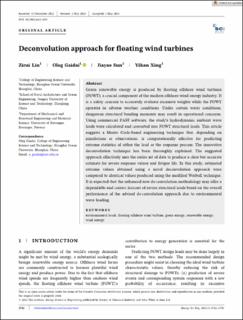| dc.contributor.author | Liu, Zirui | |
| dc.contributor.author | Gaidai, Oleg | |
| dc.contributor.author | Sun, Jiayao | |
| dc.contributor.author | Xing, Yihan | |
| dc.date.accessioned | 2023-10-16T11:22:47Z | |
| dc.date.available | 2023-10-16T11:22:47Z | |
| dc.date.created | 2023-05-29T08:19:36Z | |
| dc.date.issued | 2023-05 | |
| dc.identifier.citation | Liu, Z., Gaidai, O., Sun, J. & Xing, Y. (2023) Deconvolution approach for floating wind turbines. Energy Science & Engineering, 11(8), 2742-2750 | en_US |
| dc.identifier.issn | 2050-0505 | |
| dc.identifier.uri | https://hdl.handle.net/11250/3096714 | |
| dc.description.abstract | Green renewable energy is produced by floating offshore wind turbines (FOWT), a crucial component of the modern offshore wind energy industry. It is a safety concern to accurately evaluate excessive weights while the FOWT operates in adverse weather conditions. Under certain water conditions, dangerous structural bending moments may result in operational concerns. Using commercial FAST software, the study's hydrodynamic ambient wave loads were calculated and converted into FOWT structural loads. This article suggests a Monte Carlo-based engineering technique that, depending on simulations or observations, is computationally effective for predicting extreme statistics of either the load or the response process. The innovative deconvolution technique has been thoroughly explained. The suggested approach effectively uses the entire set of data to produce a clear but accurate estimate for severe response values and fatigue life. In this study, estimated extreme values obtained using a novel deconvolution approach were compared to identical values produced using the modified Weibull technique. It is expected that the enhanced new de-convolution methodology may offer a dependable and correct forecast of severe structural loads based on the overall performance of the advised de-convolution approach due to environmental wave loading. | en_US |
| dc.language.iso | eng | en_US |
| dc.publisher | John Wiley & Sons Ltd. | en_US |
| dc.rights | Navngivelse 4.0 Internasjonal | * |
| dc.rights.uri | http://creativecommons.org/licenses/by/4.0/deed.no | * |
| dc.subject | vindturbiner | en_US |
| dc.subject | fornybar energi | en_US |
| dc.subject | flytende vindturbiner | en_US |
| dc.title | Deconvolution approach for floating wind turbines | en_US |
| dc.type | Peer reviewed | en_US |
| dc.type | Journal article | en_US |
| dc.description.version | publishedVersion | en_US |
| dc.rights.holder | © 2023 The Author(s). | en_US |
| dc.subject.nsi | VDP::Teknologi: 500 | en_US |
| dc.source.pagenumber | 2742-2750 | en_US |
| dc.source.volume | 11 | en_US |
| dc.source.journal | Energy Science & Engineering | en_US |
| dc.source.issue | 8 | en_US |
| dc.identifier.doi | 10.1002/ese3.1485 | |
| dc.identifier.cristin | 2149889 | |
| cristin.ispublished | true | |
| cristin.fulltext | original | |
| cristin.qualitycode | 1 | |

